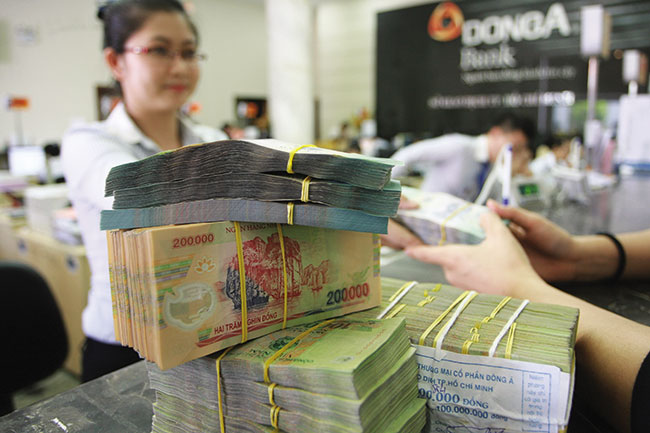Regulations slow liberalisation plans

Vietnam’s efforts to liberalise interest rates are facing a slowdown due to issues with current regulations Photo: Le Toan
By Nguyen Thi Thuy Linh-Research Department VPBank Securities Company
Allowing weak credit institutions (CIs) to go bankrupt would remove the implicit government guarantee on CIs, thereby creating for depositors a need for more accurate and insightful counterparty risk analysis, in addition to the details of benefits offered. As a counterbalance, a deposit insurance scheme would protect the interests of depositors, contribute to ensuring national financial system stability, and build a fair market for financial institutions of different scales and levels of development, so as to strengthen public confidence in the CI system.
In our article last week in the Vietnam Investment Review, we highlighted a number of benefits to scrapping deposit interest rate caps. In this article, we review the other two components of interest rate liberalisation, as they would apply in Vietnam.
The 2014 Bankruptcy Law replaced the 2004 Bankruptcy Law and 2010’s Decree 05 on the law’s application to CIs, and was enacted to overcome the shortcomings that became apparent in the course of implementing the previous regulations, while also creating new mechanisms to process bankruptcy more efficiently and better protect the rights and legitimate interests of the parties concerned. Fundamental points of the new 2014 Bankruptcy Law included provisions on the bankruptcy of CIs, which set up mechanisms that were suitable for handling such bankruptcies, covering the full range of content needed to conduct CI bankruptcy proceedings.
More recently, earlier this year, leaders of the State Bank stated that it would consider implementing bankruptcy procedures against weak finance companies and credit funds to create norms for the market, as well as to warn bankers regarding the responsibilities of their operations. The current Deposit Insurance Law was passed by Congress in 2012, and came into effect from 2013. Deposit Insurance of Vietnam (DIV), however, had been in operation since 2000, and remains the only organisation in Vietnam engaged in deposit insurance.
Under current regulations, only deposits in VND are covered, and the maximum insurance coverage for every person or organisation is VND50 million ($2,290) should a bank fail. This raises some significant issues. First, the payment limit of the current insurance scheme is considered too low. International practice places the optimal payment limit in a range from 2.5 to 5 times the per capita GDP in order to fully cover 80 per cent of deposit accounts. These limits are calculated in line with the objectives for, capacity of, and requirements imposed on deposit insurance organisations. As of June 30, 2011, Vietnam’s limit of VND50 million would fully cover only 10.23 per cent of deposit accounts, and in 2015 it represents only 1.1 times the per capita GDP.
Second, the deposit insurance charges are currently equal for all insured banks, at 0.15 per cent of insured balances, regardless of the stability or operational safety of the bank. Equal deposit insurance premium rates create dependence, discouraging banks from operating more securely to enjoy lower-cost deposit insurance, and promoting an appetite for higher risks in banking operations. In many developed countries, deposit insurance fees include two components – a fixed charge and a charge based on risk assessment. The risk-based charges have the advantage of equal treatment between CIs, and contributing to limiting risk – especially moral hazard – in banks. This needs to be implemented soon.
In short, in addition to the current policy of the authorities, there are two further issues related to deposit insurance that need to be solved before Vietnam can completely liberalise interest rates.
What the stars mean:
★ Poor ★ ★ Promising ★★★ Good ★★★★ Very good ★★★★★ Exceptional
Latest News
More News
- Banks gear up for massive capital increases (December 18, 2025 | 17:04)
- Securing capital and efficiency for Vietnam’s 2026-2030 growth ambitions (December 17, 2025 | 10:00)
- Energy sector in need of blended finance mechanisms (December 17, 2025 | 09:00)
- Vietnam still has room to mobilise capital for sustainable growth (December 17, 2025 | 08:57)
- Long-term capital seen as key hurdle to green growth (December 16, 2025 | 08:00)
- Gold prices swing amid tax debate and import uncertainty (December 15, 2025 | 18:04)
- Agribank frames bank credit as catalyst for green growth (December 15, 2025 | 17:59)
- Vietnam’s green transition demands collective financial action (December 15, 2025 | 12:00)
- VIR workshop highlights capital and policy for sustainable development (December 15, 2025 | 11:00)
- Promoting digital assets initiative in Vietnam (December 13, 2025 | 09:30)


















 Mobile Version
Mobile Version